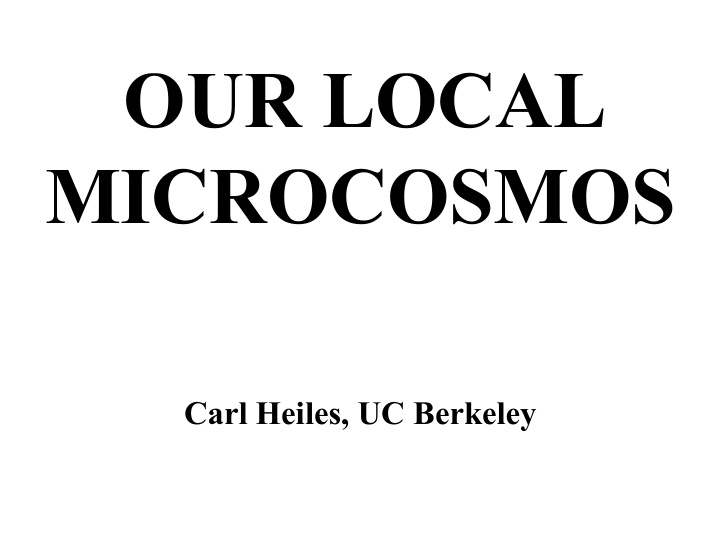



OUR LOCAL MICROCOSMOS Carl Heiles, UC Berkeley
FORCES ON INTERSTELLAR GAS: • Gravity • Pressure • Magnetic Fields
Gravity and Pressure equilibrium... the Earth’s atmosphere, nice and stable!
But things aren’t ALWAYS nice and stable!
Gravity, Pressure, and Magnetic equilibrium. Solar prominences, sunspots, nice and stable!
SOLAR FLARE – the N and S magnetic poles attract! NOT so nice and stable!
“FLUX FREEZING’’ – the magnetic lines more with the gas. And vice-versa. Nice ordered flows give nice ordered fields; or, if the field is strong, nice ordered fields give nice ordered flows. But there can be...
TURBULENCE!!
The interaction of the 3 forces—gravity, pressure, magnetism—produces fascinating and complex phenomenae and is not much understood, in either the terrestrial or astronomical context!
Simple gasdynamics: our own, our first...(LIFE magazine, post-WWII)
Nature’s: The “Orion- Eridanus Supershell”
---------------------------------------------------------------------------------------------------------------------------------------------- - ---------------------------------------------------------------------------------------------------------------------------------------------- -
This is the famed Sedov-Taylor solution. Taylor--an Englishman-- applied it to the Life Magazine photo (2 slides back) to derive the bomb energy E. He published his result in as a letter to the editor of the London Times ...
The “North- Polar Spur” (NPS) supershell (some astronomers call it “Loop I”)
The different frames are different Doppler velocities
9286 stars “Iron filings” trace the magnetic field
Rectangular projection of the whole sky. colored frames are different Doppler velocities
B follows HI morphology!
Local supershell boundaries seen from the “top of the Galaxy” To Gal cntr
Top view of our “Local Bubble”. Well-defined boundaries formed from the inside’s swept-up gas. To Gal Cntr
Local Bubble: Side view
Let’s explore the CONTENTS of the Local Bubble--it is, after all, our LOCAL MICROCOSMOS !
From the early days of the first X- ray rockets, we deduced that the Local Bubble is full of HOT GAS (about a million degrees Kelvin). We know from its X-ray emission. We see X-ray emission between us and opaque neutral gas structures.
You probably couldn’t read that. Or if you could it probably didn’t register. They are saying... ¡¡¡THERE’S NO HOT GAS IN THE LOCAL BUBBLE!!!
This is HERESY!! Generations of astronomers have grown up with X- ray shadowing data implying that the Local Bubble is full of hot gas—not from the Sun’s heliosphere. ¡SUCH IS SCIENTIFIC PROGRESS! Eventually, the truth wins out.
More contents: Possibly highly overpressured, tiny (astronomically speaking) ionized blobs. SIZE: 20000 km (a few Earth diams!) DENSITY: 1 to 100 electrons per cc OVERPRESSURE: factor 1 to 100. DISTANCE: a few parsecs (600000 AU
Australia Telescope Compact Array Very Large Array (New Mexico)
Scintillation geometry v “TWINKLING”
More Local Bubble content: a “paper-thin” cloud. THICKNESS: 4000 AU SIZE: 100 X thickness Distance: about 20 parsecs
The Arecibo telescope and the ALFA feed array. Fast HI mapping! Berkeley student Josh Goldston Peek, Profs Snezana Stanimirovic (U Wisconsin) and Mary Putman (U Michigan).
Here’s our Millennium- survey friend 3C225b, showing prominent HI absorption. We measure the temperature (17 K); we use ISM pressure (4000 cm -3 K) to get volume density. N(HI) ~ 10 19 cm -2 n(HI) ~ 200 cm -3 N(HI)=n(HI) * L WHAT’S L????
L is the thickness of the cloud along the line of sight. It’s L small: 0.02 parsecs. If this cloud were spherical, it would occupy an angle of 30 arcsec or so—tiny!
Arecibo (GALFA) map. It occupies an angle of about 10 DEGREES So it’s an ULTRATHIN SHEET, like a piece of paper.
Kitt Peak 2.1m high spectral resolution! Keck 10m. BIG, but lower resolution.
Interstellar Na I Absorption in 3C 225 Region Recent high-resolution (1.3 km/s) observations with the KPNO Coude Feed have revealed interstellar Na I toward a number of nearby stars in the 3C 225 region. The Na I lines are strong & narrow - easily detected toward even late-type stars!
and...new Keck observations show LOWER limit of 11.3 pc. Aspect ratio ≈ 1000:1, like a sheet of paper! This ultrathin sheet lies within the “Local Bubble”!
Arecibo (GALFA) map of the ultrathin sheet.
The edges show rapid variations in velocity and width; the central portions show much slower variations. The velocity fluctuations at the edges are ~0.5 km/s. For a thickness of 0.02 pc, the timescale for disruption is… Disruption time = ( L / v) = 35000 years. Disruption time = ( L / v) = 35000 years. This cloud does not exist in a vacuum. In what kind of medium is it embedded? Is the cloud evaporating into its surroundings, or are the surroundings condensing onto the cloud? Are we seeing ablation? Shredding? The velocity/width fluctuations are dynamics. Does the dynamics arise from motion through the surroundings? Or thermal processes like evaporation/condensation? Are they affected by magnetic field?
YET MORE CONTENTS OF THE LOCAL BUBBLE: Warm (about 10000 K—a lot less than a million K!) clouds, mainly atomic, partially ionized. Mapped from their absorption lines against dozens of nearby stars (Redfield and Linsky 2007).
There is some suspicion that our (1) Earth-size scintillation- producing turbulence (2) paper-thin sheet are related to intersecting boundaries of these warm clouds.
Our Local Microcosmos: • 7 nearby superbubbles, including Ori-Eri and the NPS • Local Bubble clearly defined by its dense walls. Also by X-rays? • Interstellar twinkling, VLA/ATCA: Earth-size spicules a few parsecs away • Paper-thin cloud ~20 parsecs away • 9 Warm clouds close to sun, related to above?
Basic message of science: WE ARE NOT UNIQUE WE ARE NOT THE CENTER OF THE UNIVERSE so ¡¡ALL THESE STRUCTURES MUST BE COMMON!!
Recommend
More recommend